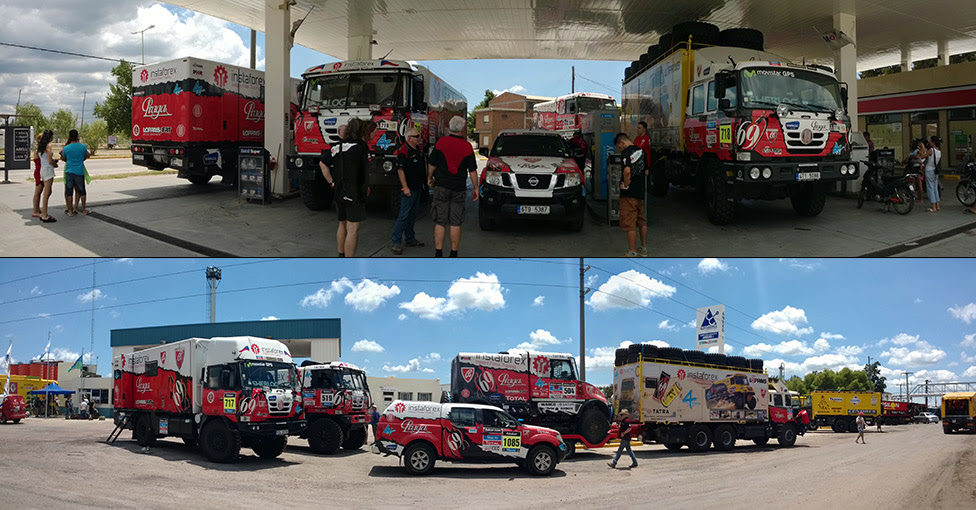Rally Dakar before the start on Sunday
04.01.2014
First reports from our team and Ales Loprais from the place of the race are good:
"Greetings to all from the South America. We are all together again and both Tatra have passed the scrutineering. We have amazing designed helmets from our fan from the Netherland. Ha made the helmets to the whole crew, we took them on the place of the race. The mood is good and the competition is great. I feel respect for all..."

Before the start of this 36th year of the Dakar Rally we bring some facts and points of interest.
Time and place: January 5 – 18, Argentina, Bolivia, Chile
Official website: www.dakar.com
Starting point: Rosario in Argentina
Finishing place: Valparaiso in Chile
Number of stages: 13
Mileage: 9374 km automobiles, 8734 km motorcycles, 9188 km trucks
First year: 1979
Most wins: Stephane Peterhansel (France) – 11
Number of crews: 438 from 52 countries
The route of the marathon race originally ran from Paris to Dakar in Senegal, from the 90th in the last century it variously changed. In 2008 the race was cancelled because od the threat of terrorist attacks, in 2009 it moved to the South America.
Defending the victory from the last year:
Cars: Stephane Peterhansel (France/Mini)
Motorcycles: Cyril Despres (France/KTM)
Quads: Marcos Patronelli (Argentina/Yamaha)
Trucks: Eduard Nikolaev (Russia/Kamaz)
Overview of the Czech and Czechoslovak best overall position:
1st place (7):
1988 - Karel Loprais/Stachura/Muck (trucks)
1994 - Karel Loprais/Stachura/Kalina (trucks)
1995 - Karel Loprais/Stachura/Tomecek (trucks)
1998 - Karel Loprais/Stachura/Cermak (trucks)
1999 - Karel Loprais/Stachura/Kalina (trucks)
2001 - Karel Loprais/Hamerla/Kalina (trucks)
2009 - Josef Machacek (quads)
2nd place (6):
1987 - Karel Loprais/Stachura/Krpec (trucks)
1988 - Jiri Moskal/Vojtisek/Zalesky (trucks)
1996 - Karel Loprais/Stachura/Tomecek (trucks)
2000 - Karel Loprais/Stachura/Gilar (trucks)
2002 - Karel Loprais/Hamerla/Kalina (trucks)
2003 - Tomas Tomecek/De Azevedo/Martinec (trucks)
3rd place (8):
1987 - Jiri Moskal/Joklik/Zalesky (trucks)
1990 - Zdenek Kahanek/Krpec/Havlik (trucks)
1992 - Karel Loprais/Stachura/Kalina (trucks)
1995 - Vlastimil Buchtyar/Koreny/Krpec (trucks)
1996 - Ladislav Fajtl/Janousek/Wurst (trucks)
1998 - Milan Koreny/Lamac/Kahanek (trucks)
1999 - Tomas Tomecek/De Azevedo/Neubarthova (trucks)
2007 - Aleš Loprais/Gilar (trucks)
Josef Machacek won even in 2000, 2001, 2003 and 2007, when the quads category was assessed only in the context of motorcycles.
Interest for this year’s race route covers the section in Bolivia, which would introduce the participants to the largest salt plain in the world – Salar de Uyuni. Although organizers plan only crossing of the motorcycles and quads (cars and trucks will go a different route), Aymara Indians want to block the race. They fear that the rubbish will remain on the salt plain after the participants and cars will damage the snow-white glossy surface. In contrast, Bolivian president Evo Morales, Aymara himself, hopes that the Dakar Rally will attract the world’s attention to this area and encourage tourism. The salt plain is situated at an altitude of 3600 meters and covers and area of more than 11 000 square kilometres. In November it always becomes a roost of South American flamingos. During the Bolivian section there is rain expected in this area which will turn a crust on the surface to the endless mirror. At the same time, however, increases the danger that the surface will break under the heavier cars. “There is only one route for everyone, and it doesn’t allow the passage of cars and trucks,” said the head of the Dakar Rallly Etienne Lavigne on the official website of the race.
We wish you a nice weekend. Count on with us hours remaining until the heaviest and the most amazing off-road race break out.



















